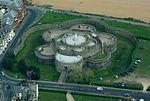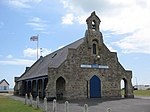Royal Marine Depot, Deal

The Royal Marine Depot, Deal (also called the Royal Marine Depot, Walmer) was a military installation occupied by the Royal Marines and located in South Deal, Kent, on the road to Walmer. The Depot (for training Royal Marine recruits) was first established in Deal in 1861, occupying part of the Royal Naval Hospital (which was linked to H.M. Naval Yard, Deal). In 1868 the Depot expanded and took over the nearby 18th-century Army barracks. From 1930, Deal served as the headquarters of the Royal Naval School of Music (founded in 1903 to provide Royal Marines bands for ships of the Royal Navy). Renamed the Royal Marines School of Music after the Second World War, it expanded to provide musical training for both junior and senior recruits for all 36 Royal Marines bands. In 1977 the training Depot closed; the site then became the headquarters of the newly re-formed 41 Commando and was renamed Royal Marines, Deal (however 41 Commando was disbanded just four years later). In 1988 parts of the site were demolished and sold for housing, leaving only the Royal Marines School of Music, which remained at Deal until 1996 whereupon it relocated to HMNB Portsmouth.
Excerpt from the Wikipedia article Royal Marine Depot, Deal (License: CC BY-SA 3.0, Authors, Images).Royal Marine Depot, Deal
Admiralty Mews,
Geographical coordinates (GPS) Address Nearby Places Show on map
Geographical coordinates (GPS)
| Latitude | Longitude |
|---|---|
| N 51.2175 ° | E 1.4022 ° |
Address
Admiralty Mews
Admiralty Mews
CT14 7AZ , Lower Walmer
England, United Kingdom
Open on Google Maps








